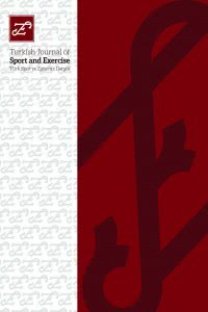Submaksimal efor sırasında farklı tip müziğin bazı fizyolojik parametreler üzerine etkisi
The effects of different types of music on some physiological parameters during a submaximal exercise
___
- 1. Abernethy P, Batman P. Oxygen Consumption, Heart Rate and Oxygen Pulse Associated With Selected Exercise-to-Music Class Elements. Br. J. Sp. Med. 1994; 28 (1): 43-46.
- 2. Altinölçek H. Bir İletişim Aracı Olarak Müzik ve Müzikle Tedavi Yöntemleri. T.C. Anadolu Üniv. Sosyal Bilimler Enstitüsü, Yayınlanmamış Doktora Çalışması, Eskişehir, 1996.
- 3. Beckett A. The Effects of Music on Exercise as Determined by Physiological Recovery Heart Rates and Distance. Journal of Music Therapy 1990; 27: 126-136.
- 4. Berstein S. Effect of Music on Muscular Endurance in College-Aged Males. Iahperd 1998; 31, 2.
- 5. Borg G. Psychophysical Bases of Perceived Exertion. Med Sci Sports Exercise 1982; 14: 377-381.
- 6. Brownley K, Mc Murray R, Hackney A. Effects of Music on Physiological and Affective Responses to Graded Treadmill Exercise in Trained and Untrained Runners. Int. J. of Psychophysiology 1995; 19: 193-201.
- 7. 7. Copeland B, Franks BD. Effects of Types and Intensities of Background Music on Treadmill Endurance. J. Sports Med. Phys. Fitness 1991; 31, 100-103.
- 8. Dorney L, Lee C. The Impact of Music and Imagery on Physical Performance and Arousal Studies of Coordination and Endurance. Journal of Sports Behavior, 1992; 15, 21-33.
- 9. Hepler C, Kapke R. Effect of Music on Cardiovascular Performance During Treadmill Walking. Iahperd Journal, 29, 2, (1996).
- 10. Karageorghis C. Using Music to Enhance Athletic Performance. Ultra-fit 1996; 6(4): 79-82.
- 11. Karageorghis C. Music for Sport and Exercise. Ultra-fit 1998; 8(6): 30-32.
- 12. Matesic B. Effects Music has on Lap Pace, Heart- Rate, and Perceived Exertion Rate during a 20- Minute Self-Paced Run. Candidate of Masters Degree, United States Sports Academy Daphne, Alabama, February, 2002.
- 13. Nethery VM, Harmer PA, Taaffe DR. Sensory Mediation of Perceived Exertion during Submaximal Exercise. Journal of Human Movement Studies, 1991; 20, 201-211.
- 14. Pates J, Fryer R, Maynard I. Effects of Asynchronous Music on Flow States and Shooting Performance Among Netball Players, 2001.
- 15. Potteiger J, Schroeder J, Goff K. Influence of Music on Ratings of Perceived Exertion during 20 Minutes of Moderate İntensity Exercise. Perceptual and Motor Skills 2000; 91, 848-50.
- 16. Schwartz SE, Fernhall B, Plowman SA. Effects of Music on Exercise Performance. Journal of Cardiopulmonary Rehabilitation, 1990; 10, 312-316.
- 17. Szabo A, Small A, Leigh M. The Effects of Slowand Fast-Rhythm Classical Music on Progressive Cycling to Voluntary Physical Exhaustion. J. Sports Med. Phys. Fitness 1999; 39, 220-225.
- 18. Szmedra L, Bacharach DW. Effect of Music on Perceived Exertion, Plasma Lactate, Norepinephrine and Cardiovascular Hemodynamics during Treadmill Running. Int. J. Sports Med. 1998; 19, 32-37.
- 19. Tan H. Psikolojik Danışma ve Rehberlik, Öğretmen Kitapları Dizisi, İstanbul, 1995.
- 20. Ward P, Dunaway S. Effects of Contingent Music on Laps Run in a High School Physical Education Class. The Physical Educator, 1995; 52(1), 2-7.
- ISSN: 1300-9915
- Yayın Aralığı: Yıllık
- Başlangıç: 2018
- Yayıncı: -
Participation in homework exercise and its effects on physical fitness in Turkish adolescents
NURİ KARABULUT, HÜSEYİN ÇAMLIYER
Yağlı güreşlere yönelik tutum ölçeğinin geliştirilmesi
Antinea AMBRETTI, Filippo PALOMA GOMEZ, Nadia CARLOMAGNO, Raffaele PROSPERİ, Maurizio SIBILIO
Basketbolcuların oyun pozisyonlarına göre reaksiyon zamanlarının karşılaştırılması
Drop sıçramada optimal platform yüksekliğinin belirlenmesi
TÜLİN ATAN, M. Yalçın TAŞMEKTEPLİGİL, Seydi A. AĞAOĞLU, MENDERES KABADAYI, ÖZGÜR BOSTANCI, OSMAN İMAMOĞLU
AYŞEGÜL ŞÜKRAN ÖZ, HÜSEYİN KIRIMOĞLU, Ali TEMİZ
Pilates’in durum analizi: Eskişehir il örneği
DENİZ ŞİMŞEK, KEREM YILDIRIM ŞİMŞEK
Hakan Salim ÇAĞLAYAN, Mehmet Çağrı ÇETİN, YUNUS YILDIRIM, Özer YILDIZ
New technologies for motor didactics
Nadia CARLOMAGNO, Stefano TORE DI, Rosa SGAMBELLURİ, Veronica FRAGNITO, Filippo PALOMA GOMEZ
